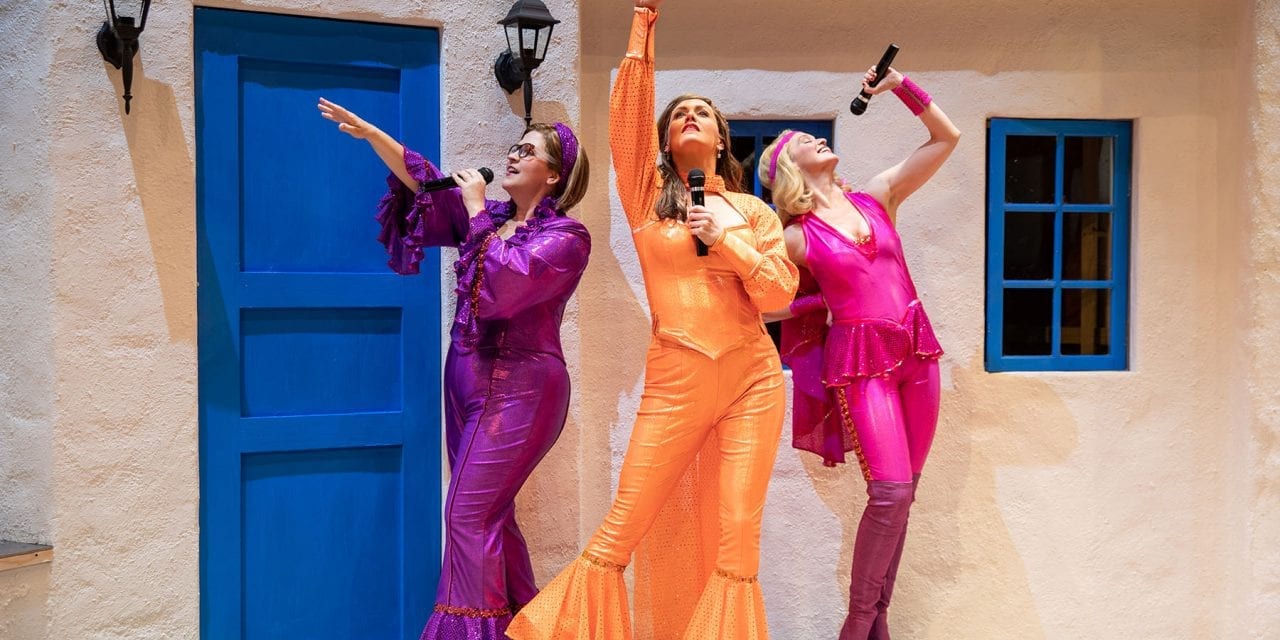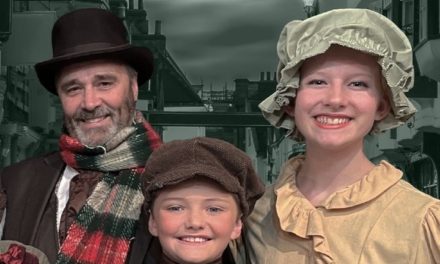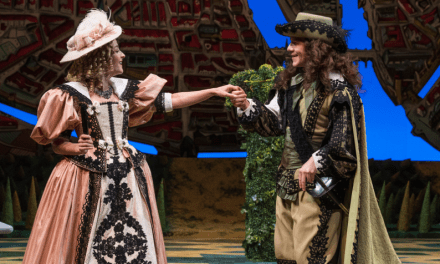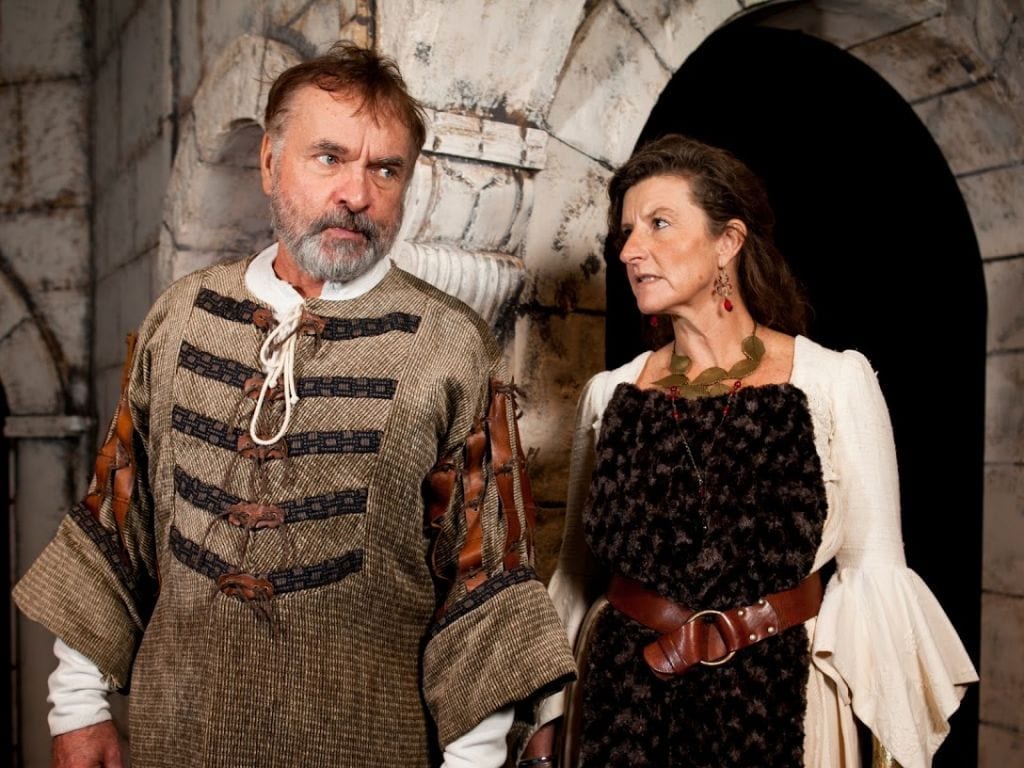SALT LAKE CITY — In her director’s notes for Mamma Mia!, Patricia Wilcox wrote, “What is left to say about a show that has been seen by 60 million people in 40 countries and has been translated into 23 languages?” Indeed. The task is no easier for a reviewer. So, let me state simply that this version of Mamma Mia! is a very powerful production in every respect.

Show closes May 26, 2018.
For those unfamiliar with the smash hit, Mammia Mia! (with a script by Catherine Johnson) is the tale of Sophie (played by Kathryn Brunner) and her single mom, Donna, who run a taverna on a Greek island. Sophie is getting married to her boyfriend Sky, and she invites to her wedding three men who could be her father, Sam (played by Brian Sutherland), Harry (played by Paul Castree), and Bill (played by Dan Sharkey). Each man had a fleeting relationship with Donna about the time when Sophie was conceived. Naturally, confusion abounds, and there are many opportunities for situational and verbal humor, as the three men show up, along with Donna’s backup singers from her musical performing days (played by Amy Bodnar and Mary Fanning Driggs).

Coleen Sexton as Donna and Kathryn Brunner as Sophie.
It is a thin story, particularly because Sophie insists on learning the wrong lesson from her mother’s experience (as seems to be apparent from the upcoming sequel Mamma Mia! Here We Go Again, to be released later this year). The plot serves primarily as a wall on which to hang the songs of the Swedish singing group ABBA (with music and lyrics by ABBA group members Benny Andersson and Björn Ulvaeus). Because the songs were written primarily for a quartet, the soloists frequently need backup. This supporting chorus often sings from on stage, but sometimes also emerges eerily from under beds and out of rocks or walls. These songs are the real point of the production.
The voices are all strong, with perhaps special mention needed for Coleen Sexton as Donna. Brunner as Sophie and Aidan Wharton as Sky also impress, especially because they are non-Equity performers. The non-singing and acting components of the production are equally impressive. The older actors in the cast (Sutherland, Castree, and Sharkey as the three “fathers,” Sexton as Donna, and Bodnar and Driggs as Donna’s wingwomen) turn in very strong performances. They are a pleasure to watch on stage, and in the musical numbers are endlessly appealing. Wilcox extracts maximum benefit from their interactions, leaving me with a strong sense of the personalities of all the principals.
Because of the strong direction and believable performances, I had a strong sense of what the characters have been up to in the last 21 years. The result was a nice balance between the inevitable nostalgia and the demands of the present and future. Those who have participated in high school or college reunions can validate the extent of the changes in our past acquaintances. I recognize figures from our own past, who carry on them the marks of whatever life they have chosen. They are older, of course, but qualitatively different as well. It is astonishing that Donna so quickly recognizes Bill Austin in his Indiana Jones persona, and surely Harry Bright’s homosexuality has to come as a shock. Verisimilitude is not required in a story as thin as this. But still, it’s a tribute to actors and director that Mamma Mia! works as well as it does.
The engaged couple also work well together. Brunner and Wharton project a happy satisfaction with their situation, but looking forward to their life together. This combination of satisfaction and anticipation shown in their enjoyment of the hen/stag parties given by their friends set against their personal interactions and the chemistry between them. And speaking of the stage party, watch for the men high-stepping in their frogman flippers in a show-stopping dance number.

Left to right: Brian Sutherland as Sam, Paul Castree as Harry, and Dan Sharkey as Bill.
Consequently, fans of ABBA songs will love this production of Mamma Mia!. Otherwise, they are pretty tuneful (if somewhat monochromatic), well-played (kudos to the orchestra, conducted by Helen Gregory), easy to follow, and seamlessly integrated into the story. This is disco music, as was made abundantly clear by the “bows” encore for which the cast appeared in glorious white, flashy, sequined costumes to reprise the three most famous of ABBA hits: “Mamma Mia,” “Dancing Queen,” and “Waterloo.”
The costumes designed for these bows were spectacular, but indeed all the costuming (designed by Brenda Van Der Wiel) was well done, as was the choreography (also created by Patricia Wilcox). The set, designed by James Kronzer was ingenious, morphing beautifully from taverna exterior to different bedrooms inside.
The bottom line is that fans of ABBA should go see Pioneer Theatre Company’s Mamma Mia!. Audience members who are unfamiliar with ABBA can still enjoy the show because this production is a good introduction to the group’s music. People who hate ABBA or disco should stay away. But who are you to stand against one of the most successful recording groups ever?
Donate to Utah Theatre Bloggers Association today and help support theatre criticism in Utah. Our staff work hard to be an independent voice in our arts community. Currently, our goal is to pay our reviewers and editors. UTBA is a non-profit organization, and your donation is fully tax deductible.





